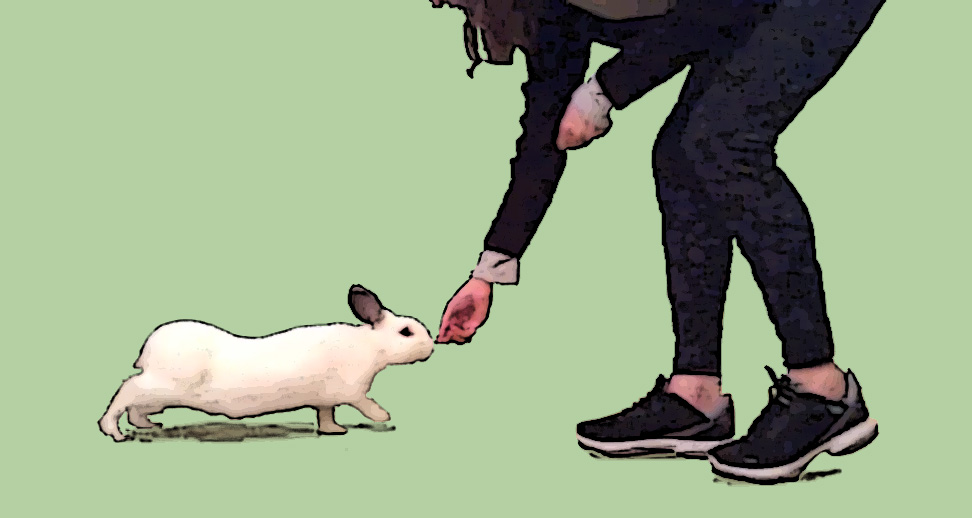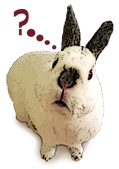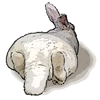
Luring is a basic tool that is used routinely to move dogs around, distract them, or to initiate new behaviors like “sit” or “down”. It’s like the Swiss army knife of dog training. Just hold out a nice, tasty treat and Fido will follow you anywhere. But can you lure a rabbit?
You sure can.
It’s a simple and easy skill you can practice with your bun. It can come in handy for training other things, or any time you want your bunny to move. For example, a behavior like standing up on the hind legs or hopping up on a platform can be taught with a lure.
How to do it
Learning to lure is pretty straightforward. Just follow a few simple rules:
- Choose a lure with high enough value to your rabbit so he’ll consider it worth the trouble. The more fragrant the better.
- Keep it “on” the rabbit’s nose. That means it should be very close to if not touching the nose at all times without letting bun-bun grab and eat it. Don’t move faster or slower than your hopping student.
- Keep the lure at a comfortable height so fuzz-face doesn’t have to strain his neck to keep his nose on it. Assuming you are standing or walking, this will unavoidably entail some serious bending over. I don’t know any way around that. As my workout coach always tells me, keep your abs tight to protect your back!
 What’s a High-Value Treat?
What’s a High-Value Treat?
Value in a treat, like beauty, is in the eye of the beholder. A new set of fancy golf clubs might be irresistible to some people, whereas I would prefer a nice piece of antique furniture.
The same is true for animals. If your rabbit rarely gets cereal pellets then they might be high enough value to use as a lure in certain circumstances, such as when he’s hungry, alert, and not distracted. If pellets are freely fed all day, they ain’t gonna cut it.
The more protein and/or carbs in a food, the higher value it will be. Things like alfalfa, treat cookies, and fruits will be higher in value. And of course each bun will have their personal favorites.
- ALWAYS hand over the lure if the animal follows it: not immediately perhaps; ideally, when you get to your destination, but above all, do it before he loses interest. Don’t be a tease. Your bun will soon learn to ignore your lure unless you consistently provide a pay-off for his trouble.
That’s pretty much all there is to it! Here are some videos of me working on luring with Finnegan and Moraea.
Luring Examples
Sample 1: Luring with a known yummy food
Here, I am luring Finnegan with a dried cranberry. This is a very high value treat — full of sugar, one he likes a lot and only gets on rare occasions. I have put a divider across the room and kept Moraea busy with a small bowl of pellets, so she’s nowhere in range. He’s going to stick with me, even when I occasionally move the lure an inch or two from his nose.
Sample 2: Luring with a yummy food when other food is readily available
Here, Moraea is busy munching her pellets and she’s hungry enough that she’s kind of engrossed in them. So, at first, the cranberry isn’t grabbing her attention. She’s much more enthusiastic once I take the pellets away. (Don’t worry, I gave them back after we were done!) Notice that I wait for her to finish chewing and demonstrate her interest in me before I try again. Even though it takes her a ridiculously long time to stop. But then she follows with enthusiasm.
Sample 3: Luring both bunnies with a novel food
In this video, I’m using dried mulberries. This is a food neither bun had ever eaten before. As a dried fruit it’s pretty high value and certainly should be fragrant to their noses. Moraea, who is a fearless she-warrior rabbit, goes right for it, and she’ll follow wherever I go. Finnegan is more cautious. He isn’t sure what to think of this new stuff. He only follows when it’s comfortable to do so and demurs from eating it when I finally offer it to him. (It even looks like he’s shaking his head “no”!)
Luring Failures
Feeding your whisker-nose a high value treat every time establishes a strong history of good experiences, which will make the lure more enticing and therefore strengthen his response to it. But just as with dogs, luring isn’t fool proof. In a highly distracting environment, such as one with another rabbit in it, it’s likely your bun will be too interested in what the other guy is doing to care about the lure. Similarly, if your lure isn’t as yummy as other things that are available, or if your bun isn’t hungry, you’re going to strike out.
In this video, my husband David and I are trying to lure the rabbits away from each other. I’m working with Moraea, and David is working with Finnegan. In the first attempt, you can see that Finnegan is more interested in Moraea than the carrot. He only shows interest if it’s close enough for him to grab and eat. A higher value treat is needed in this situation and it should be held in such a way that it can’t be snatched away.
In the second attempt, David is holding the carrot too far from Finnegan’s nose, so our finicky follower abandons the lure entirely.
 The Fluffy Tail of This Blog Post
The Fluffy Tail of This Blog Post
Next time you want to give your bun a high-value treat, consider using it to practice luring. Getting good at this technique can be very handy for training and management of your rabbit.
Syl says:
I guess rabbits are like little siblings,– they want whatever the other one has.
P.S. I like cranberries too!!
Melinda says:
Syl,
Yep! They are not shy about getting right in there and grabbing what they can! That’s just how they are.